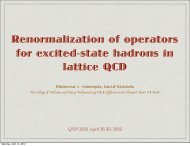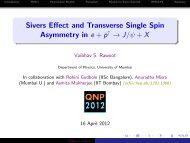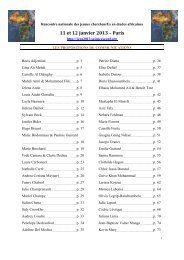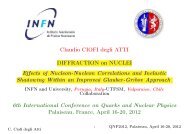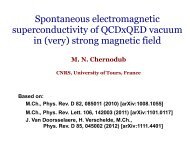Susan Schadmand - QNP2012
Susan Schadmand - QNP2012
Susan Schadmand - QNP2012
Create successful ePaper yourself
Turn your PDF publications into a flip-book with our unique Google optimized e-Paper software.
WASA-at-COSY<br />
Rare Meson Decays and<br />
Transition Form Factors<br />
Mitglied in der Helmholtz-Gemeinschaft<br />
<strong>Susan</strong> <strong>Schadmand</strong>, IKP & JCHP<br />
talk at QNP 2012 - 16-20 April 2012<br />
Palaiseau (France)
meson decays<br />
a laboratory for the strong interaction<br />
→ symmetries and symmetry violation<br />
→ isospin symmetry breaking, quark mass differences<br />
→ test predictions, obtain parameters<br />
→ electromagnetic properties, transition form factors<br />
→ non conventional effects beyond standard model<br />
Mitglied in der Helmholtz-Gemeinschaft<br />
MesonNet<br />
Meson Physics in<br />
Low-Energy QCD<br />
April 2012 WASA-at-COSY<br />
2
experimental approach and analysis<br />
beam from accelerator<br />
P ~ GeV/c<br />
target nucleus<br />
P=0<br />
detection of decay<br />
and recoil particles<br />
and their momenta<br />
Meson<br />
• reactions: p+d → 3 He+meson and p+p→p+p+meson<br />
• particle tracking & identification, reconstruction<br />
• missing mass method: meson tagging<br />
1.0GeV p+d → 3 HeX<br />
D.Coderre<br />
1.4GeV p+p →ppX trig<br />
Mitglied in der Helmholtz-Gemeinschaft<br />
April 2012 WASA-at-COSY<br />
3<br />
D.Coderre<br />
'inclusive '<br />
η peak at<br />
MM=547MeV
experimental approach and analysis<br />
beam from accelerator<br />
P ~ GeV/c<br />
target nucleus<br />
P=0<br />
detection of decay<br />
and recoil particles<br />
and their momenta<br />
Meson<br />
Mitglied in der Helmholtz-Gemeinschaft<br />
• reactions: p+d → 3 He+meson and p+p→p+p+meson<br />
• particle tracking & identification, reconstruction<br />
• missing mass method: meson tagging<br />
• detection of all decay products<br />
• kinematic conditions / kinematic fitting<br />
• background suppression and subtraction (other decays)<br />
• background subtraction (bin-wise) of multi-pion production<br />
• systematic effects<br />
total & differential cross sections, , upper limits,<br />
Dalitz plots, branching ratios, form factors, ...<br />
1.0GeV p+d → 3 HeX<br />
1.4GeV p+p →ppX trig<br />
April 2012 WASA-at-COSY<br />
4<br />
D.Coderre<br />
D.Coderre
physics around transition form factors<br />
o<br />
electromagnetic structure / coupling<br />
o<br />
phenomenological vector meson dominance calculations fail to describe the transition form<br />
factor of the ω meson<br />
o<br />
new strategies for processes at higher energies with additional degrees of freedom<br />
o<br />
closely related: π o →γ e + e - and η→γ e + e - , and in e + e - →e+e-pi 0 production processes<br />
o<br />
π o form factor needed for the interpretation of g-2 and π o →e + e - experiments<br />
(plus possible search for U boson in Dalitz dileptons)<br />
Mitglied in der Helmholtz-Gemeinschaft<br />
o<br />
inportance of 3π final states (proper treatment of hadronic final-state interactions)<br />
April 2012 WASA-at-COSY<br />
5
motivation for Dalitz plot analysis π + π - π 0<br />
probing isospin violation (for pseudoscalar mesons)<br />
+ hadronic final-state interactions<br />
access to light quark mass ratios<br />
extract from decay width<br />
test with experimental Dalitz plot distributions<br />
decay width Dashen limit<br />
Q D = 24.2<br />
expansion<br />
Dalitz plot density<br />
Mitglied in der Helmholtz-Gemeinschaft<br />
Dalitz plot parameters:<br />
comparison with theory<br />
recent experimental result<br />
April 2012 WASA-at-COSY<br />
Slide 6
status η → π + π - π 0<br />
analysis Patrik Adlarson (Uppsala)<br />
goal: Dalitz plot analysis of the three pions<br />
‣10 7 η events from pd→ 3 Heη analyzed<br />
‣bin-wise background subtraction<br />
‣2 x 10 5 events in Dalitz plot<br />
Mitglied in der Helmholtz-Gemeinschaft<br />
preliminary results for Dalitz plot parameters pending<br />
(thesis writing in progress)<br />
more data available in pp → ppη<br />
Dalitz plot also studied with ω → π + π - π 0<br />
April 2012 WASA-at-COSY<br />
Slide 7
status ω→π 0 π + π -<br />
goal: Dalitz plot analysis of the three pions<br />
first step: missing mass analysis, with preliminary decay channel selection<br />
1.5 GeV p+d<br />
Lena Heijkenskjöld(Uppsala)<br />
Siddesh Sawant (IIT Bombay)<br />
2.063GeV p+p<br />
15% of available data sets<br />
9152 ω→π 0 π + π -<br />
50% of pilot run<br />
• simulation ppπ 0 π + π -<br />
(phase space, arb. norm.)<br />
• background subtracted signal<br />
Mitglied in der Helmholtz-Gemeinschaft<br />
3<br />
HeX(3π): peak is the result of careful tuning of the<br />
reconstruction and calibration for forward He particle<br />
(stopped in detector)<br />
expectation: ~1 ω/s<br />
ppX(3π): at this stage, ω only a shoulder above<br />
(multi pion) background in p+p reaction<br />
issue: high energy protons<br />
expectation: ~100 ω/s<br />
April 2012 WASA-at-COSY<br />
8
Dalitz (conversion) decays of mesons<br />
1 - F=1 (QED)<br />
2 - |F(q 2 )|> 1 (VMD)<br />
3 - |F(q 2 )|< 1<br />
affects branching ratio<br />
~<br />
Mitglied in der Helmholtz-Gemeinschaft<br />
'standard VMD'<br />
April 2012 WASA-at-COSY<br />
9
world data set I: conversion decays with µ + µ -<br />
for ω meson, clearly additional mechanisms<br />
apart from standard VMD<br />
Mitglied in der Helmholtz-Gemeinschaft<br />
• confirmed by NA60 AA reactions, S. Damjanovic, PLB 677 (2009) 260<br />
• confirmed by NA60 pA reactions, A.Uras, J.Phys. Conf.Ser.270(2011)012038<br />
• recent theoretical advance: C. Terschlüsen and St.Leupold, Phys.Lett. B691 (2010) 191-201<br />
chiral Lagrangian including light vector mesons and Goldstone bosons<br />
different experimental approach: elementary reactions, using di-electrons<br />
April 2012 WASA-at-COSY<br />
10
world data set II: conversion decays with e + e -<br />
SND<br />
η→γe + e -<br />
b η =(1.6±2.0)GeV -2<br />
more η results:<br />
improved statistics, photon detection<br />
• Crystal Ball and TAPS at MAMI-C<br />
• Henning Berghäuser (γ+p)<br />
Phys.Lett. B701 (2011) 562<br />
• WASA-at-COSY<br />
• Himani Bhatt (IIT Bombay) (p+p)<br />
• Malgorzata Hodana (Krakow) (p+d)<br />
CMD-2<br />
ω→π 0 e + e -<br />
b ωπ =(2.5±3.1)GeV -2<br />
CMD-2<br />
φ→ηe + e -<br />
b φη =(3.8±1.8)GeV -2<br />
Mitglied in der Helmholtz-Gemeinschaft<br />
WASA-at-COSY<br />
• Farha Anjum Khan<br />
(Jülich) (p+d)<br />
• Ankita Goswami<br />
(IIt Indore) (p+p)<br />
KLOE<br />
• Jaroslaw Zdebik<br />
(Cracow) (e+e)<br />
April 2012 WASA-at-COSY<br />
11
status η→γ e + e -<br />
goal: transition form factor studies<br />
Malgorzata Hodana (Krakow)<br />
1.0GeV p+d<br />
based on 10 7 3 Heη<br />
background suppression<br />
based on<br />
← selective cuts<br />
525±26 events<br />
all data: 3∙10 7 3 Heη<br />
+kinematic fit →<br />
3084±55 events<br />
all data: 5∙10 8 ~10 9 η(trig)<br />
Himani Bhatt (IIT Bombay)<br />
1.4GeV p+p<br />
based on 10 7 ppη<br />
still background issues<br />
suspect background from2π<br />
Mitglied in der Helmholtz-Gemeinschaft<br />
to do: reconsider cuts and do systematic studies<br />
data set pd: full data set and kinematic fit<br />
data set pp: much more data, real chance for precision<br />
and more background, thus:<br />
fine-tune calibrations, re-tune kinematic fit,<br />
bin-wise background subtraction<br />
April 2012 WASA-at-COSY<br />
12
towards the ωπ transition form factor<br />
first step: reference channel ω→π 0 γ from p+d<br />
Farha Anjum Khan (Jülich)<br />
Mitglied in der Helmholtz-Gemeinschaft<br />
estimate: ~1.4 x 10 6 ω produced with both data sets (1.5 and 1.45 GeV p+d)<br />
fast simulation of ω→π 0 ee (background-free) would promise ~160 events (too optimistic...)<br />
further data sets: pilot runs using p+p reaction (analysis Ankita Goswami (IIT Indore) )<br />
→ experimental conditions for high statistics run<br />
April 2012 WASA-at-COSY<br />
13
summary<br />
• light meson decays in the low energy regime of QCD<br />
• WASA has been taking valuable data on several key aspects<br />
• η meson decays:<br />
• 3x10 7 η mesons produced in pd → 3 HeX<br />
• 5∙10 8 ~ 10 9 η decays in pp → ppη<br />
• experimental goal: very rare meson decays η→e + e - and η→π 0 e + e -<br />
• down to branching ratios below 10 −8 (standard model)<br />
Mitglied in der Helmholtz-Gemeinschaft<br />
• ω decays in pd->3HeX and pp pilot runs<br />
• goal: precise determination of ωπ transition form factor<br />
• 3π final states<br />
• high-statistics production run planned<br />
April 2012 WASA-at-COSY<br />
14



